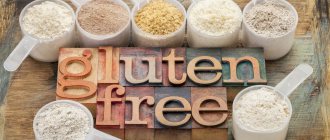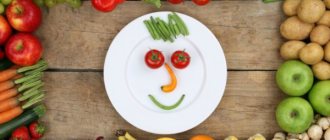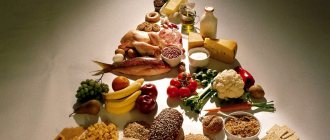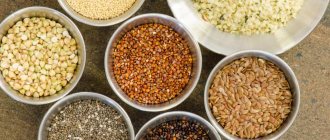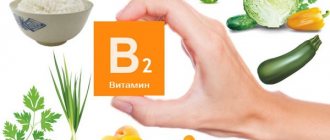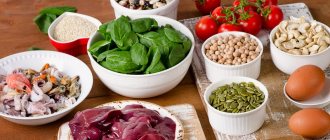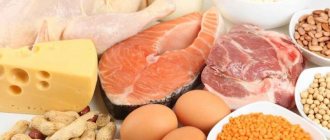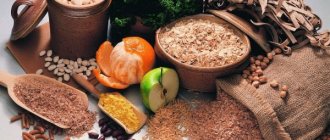Potassium is an integral part of the complex of macroelements that the body needs for normal functioning, so knowing which foods contain the most of it will be useful for those who monitor their health. The absence of this substance will negatively affect the functioning of the heart muscle, the condition of many systems and bones. Without it, muscles and internal organs work and form much worse. How to properly create a nutrition program so as not to miss such an important element - we’ll figure it out together with a specialist from the Elena Morozova clinic.
Beneficial properties and effects on the body
This is one of the most important components of a person’s daily diet, which helps maintain the balance of electrolytes and fluids. With its help, you can improve the performance of the nervous system, reduce the likelihood of a stroke and balance blood pressure. Nature provides a component that helps protect blood vessels from damage and oxidation. In combination with other substances, it regulates the functioning of the gastrointestinal tract and relieves increased fatigue. Therefore, we recommend eating foods that contain a lot of potassium.
Nutritionist's comment:
It is necessary to ensure the balance of macroelements, especially those involved in the transmission of nerve impulses and control of the cardiovascular system. You cannot mindlessly go on a diet that can deprive the body of useful elements, wash them away, and make bones weak and susceptible to damage. With a deficiency, most organs fail and processes are disrupted.
The importance of shaping your diet is obvious. The absence of important substances in the human body will have a detrimental effect on his health. What contains a lot of potassium, and what foods contain it, is especially worth knowing for people on a diet and nursing mothers. Elderly people should also read the information, since their rate of absorption of elements is much lower.
Our additional services: Bioimpedance | Marutaka Massage | Pressotherapy | Ion-Detox
In general, the following advantages can be highlighted:
What else is a macronutrient required for in the body:
- healthy kidneys - stones will not form if you maintain balance;
- improved brain function - cells are saturated with oxygen, memory ability increases;
- elastic skin – it is important to maintain the level of moisture in the epidermis, this helps prevent early aging;
- strong muscles – the converted energy provides strong and elastic fibers, it will become easier to perform physical exercises;
- simplified digestion - carbohydrates are easier to process;
- sugar levels are stabilized - if you consume potassium-containing foods, you can stimulate the production of insulin in the blood.
Why do we need potassium?
You can’t live without potassium! In the adult body, the normal daily potassium intake is about 2000-5000 mg; for children the norm is 600-1700 mg. Potassium creates conditions for the occurrence of muscle contractions, uninterrupted supply of oxygen to the brain, maintaining acid-base balance and normal osmotic concentration of blood; it also maintains membrane potential, which is so important for the body’s water balance. Without potassium, the functioning of the kidneys, nervous system and gastrointestinal tract is disrupted.
In addition, potassium is involved in metabolism: it synthesizes protein and converts glucose into glycogen. Therefore, foods high in potassium should be included in your diet every day.
Potassium deficiency
What are the dangers of potassium deficiency? Muscle weakness, cramps, fatigue, mental exhaustion, threatening persistent depression, decreased immunity, malfunction of the adrenal glands, high blood pressure, predisposition to atherosclerosis - these are hidden manifestations of potassium deficiency. Externally, a deficiency of a microelement manifests itself in symptoms such as:
- fragility and dullness of hair;
- drying and flaking of the skin;
- the appearance of bruises from the slightest blow;
- peeling of nails.
If the body does not have enough potassium, frequent vomiting, diarrhea, and excessive sweating may occur. Prolonged potassium “starvation” can negatively affect reproductive function in both women and men. By the way, due to a lack of potassium, men are at risk of fatal strokes 3 times more often than for other reasons. This is why potassium is so needed in food.
Vegetarians and dieters, as well as athletes and the elderly, have the greatest need for potassium. Why is potassium lost? Due to heavy physical activity, nervous tension and stress, poor nutrition, taking antibiotics and excessive consumption of salty foods and caffeinated drinks. Potassium is best absorbed with the simultaneous consumption of B vitamins. The worst absorption occurs with alcohol consumption.
Excess potassium
But an excess of potassium is also unsafe: hyperactivity and irritability, poor sleep, disruption of the gastrointestinal tract, arrhythmia, the risk of developing diabetes mellitus - these are the dangers of hyperkalemia.
If you follow a diet where potassium-containing foods predominate, potassium medications should be discontinued or the dosage reduced. It is especially important for pregnant women to monitor this: many vitamin and mineral complexes already include potassium, so you should not be overzealous with consuming it from foods. Increasing physical activity helps quickly get rid of excess potassium: an excellent chance to learn a new sport or go hiking, for example.
How to identify deficits and surpluses
If a person has to take diuretics daily or eats a lot of salty foods, he or she is at risk. Bad habits and constant intense physical activity can also lead to deficiency.
It is important to pay attention to the following symptoms:
- loss of appetite;
- apathy and drowsiness;
- fatigue;
- the appearance of aversion to food, except that which contains potassium;
- painful muscle spasms;
- broken stool;
- reduced immunity;
- constantly thirsty;
- wounds do not heal for a long time;
- nails break and hair splits or falls out;
- the skin is peeling.
Nutritionist's comment:
Particularly serious consequences can result from the appearance of a deficiency in women of reproductive age. This can lead to the onset of infertility, serious complications in the pregnant woman and cause several diseases at the same time. Therefore, it is better to know exactly which foods are high in potassium and consume them in the required quantity.
An excess of this mineral in the human body is no less dangerous. Daily consumption of more than 6000 mg of the substance is considered toxic, which leads to other health problems. Severe malaise appears, the face and limbs swell, and there is a constant urge to urinate. All this is accompanied by low blood pressure, sweating, abdominal pain and constant nervous tension that is impossible to cope with.
Foods rich in potassium:
Let's first find out which products contain this element. So, among the fruits we can note dogwood, peaches and dried apricots, apricots, raisins, apples, grapes, cherries, currants. Vegetable sources of potassium are: potatoes, cabbage, carrots, onions, tomatoes, peas, beans.
Among animal products, potassium is found in cod, hake, mackerel, squid, beef, veal, and pork.
Let's remember the foods we know that are rich in potassium. Bananas are probably the first thing that comes to mind. It's right. But the list of plant crops that are sources of potassium is much more extensive. The record holders in this regard are dried grapes (known to us as raisins), dried apricots, bananas, peaches and apples. Watermelons, melons, pears and strawberries are somewhat poorer in this chemical element.
An interesting fact is that dried fruits are significantly higher in potassium content than fresh fruits.
Sufficient consumption of such products helps prevent deficiency of this mineral in the body, and therefore serious health problems.
Top 10 foods with the highest and highest potassium content
With normal nutrition, the body should receive 250 g of the substance. To provide yourself with a regular supply of beneficial macronutrients, it is recommended to consume daily:
- for children – 600-1800 mg;
- for adults – 1800-2200 mg;
- for pregnant women – 3500 mg;
- for athletes and people engaged in heavy physical labor – up to 4500 mg.
The need for this component varies depending on a person’s weight, region of residence and diet. For prolonged illness and diarrhea, it is necessary to increase the dosage to avoid critical loss.
Foods containing potassium and magnesium
The daily need for magnesium and potassium is affected by weight, physical activity, physical activity, and health status. If a person is engaged in heavy physical labor, then the list includes foods that contain the maximum amount of minerals (nuts, seaweed, oatmeal, buckwheat, peas, greens).
Plant foods contain increased amounts of alkaline nutrients. Cereals, sorrel, spinach, parsley, beets, carrots, and raspberries are rich in minerals.
The highest concentrations of potassium and magnesium are found in peanuts, hazelnuts, seaweed and beans. Also, the highest mineral content is found in rolled oats, walnuts, and beans. High concentrations of nutrients were found in potatoes, rice, tomatoes, and green onions.
Among fruits, bananas, black currants, watermelons, and cherries have the highest content of potassium and magnesium. Minerals are found in eggs, dairy products, mushrooms, and honey.
Find out more about our weight loss programs:
List of foods rich in potassium:
- potato;
- tomatoes, preferably sun-dried;
- beans;
- dried apricots;
- prunes;
- avocado;
- salmon;
- spinach;
- pumpkin - especially seeds;
- orange.
Nutritionist's comment:
It is not enough to simply eat fish or fruit. It is necessary to simultaneously maintain the balance of sodium, calcium and other beneficial macroelements. The regimen should consist of several meals, each of which will contain part of the daily diet. It is better to change taste habits and preferences under the supervision of experienced specialists, and not on your own.
Which foods contain the most potassium?
Dried apricots. The dried fruit contains a large amount of potassium. If you are deficient in this mineral, eat more dried apricots. It perfectly satisfies hunger; it is enough to eat only 2-3 pieces. It can be used as a snack during the day, replacing sweets and cakes with it. This is an effective remedy that many women use to lose weight.
Cocoa. It refers to foods high in potassium. It contains vegetable protein, sucrose, carbohydrates, vitamins, and minerals. It reduces the risk of cardiovascular diseases, slows down the aging process, improves mood, and helps fight depression. It restores strength after illnesses. Due to its high calorie content, nutritionists do not recommend drinking more than two cups of cocoa per day.
Raisin. The product ranks first in terms of potassium content. It has many beneficial properties and is necessary for the proper functioning of all organs and systems. Raisins strengthen the heart, blood vessels, and improve liver function. It is used for the prevention and treatment of many diseases.
Nuts. This is a very healthy and high-calorie product. If you consume a little of them, you will not be overweight. They contain a large amount of vitamins and minerals. They belong to foods rich in potassium. Almonds and pine nuts are especially useful.
Avocado. The fruit contains a large amount of potassium. By including avocado in your diet, you can replenish your body's potassium reserves.
Baked potato. This is a simple, low-calorie, very healthy dish. It is recommended to be included in the diet for cardiovascular and kidney diseases, but it should be unsalted. When baked, the vegetable retains its beneficial substances. It should be eaten with the peel.
Bananas. Bananas are a delicious treat for children and adults. They can be consumed separately, or added to porridge, cottage cheese, or prepared in banana smoothies. They make tasty and healthy dishes that enrich the body with essential substances.
Beans. Beans contain a large amount of potassium. You can cook borscht and soups with it. There are many recipes for preparing delicious and healthy dishes with beans.
Sea kale. Seaweed contains a large number of useful substances, including potassium. It is recommended to use it for heart disease, problems with the thyroid gland, and to strengthen the nervous system. You can eat it raw or cook a variety of dishes with it.
Spinach. Greens are good for heart health and the whole body as a whole. It is best consumed fresh. Add spinach to ready-made first and second courses, vegetable salads, and make spinach juice.
Kiwi. The overseas fruit contains a lot of potassium. Kiwi can be eaten separately or prepared in salads. Everything will depend on your preferences.
Table of the highest potassium content in foods
You should also not lose sight of the ratio of benefits and calorie content in selected fruits, vegetables and dishes. You can even do without pharmacy vitamins if you create a menu correctly. Properly organized quantity and quality of food allows you to get rid of deficiency. First of all, you should eat vegetables and fruits. It is necessary to strive to bring their daily volume to a third of the total eaten. Using such a strategy is the right decision for those who are watching their figure or health.
Table of foods containing large amounts of potassium:
Balance of potassium and magnesium
Magnesium is essential for heart and blood vessel health. But it is not able to perform its functions without potassium. In tandem, these nutrients restore metabolism in the myocardium and improve heart function.
By consuming foods with potassium and magnesium, a person prevents the occurrence of dangerous pathologies. If you increase the proportion of food containing these nutrients in your diet, the likelihood of developing atherosclerosis and heart pathologies will decrease.
Doctors recommend that patients who have had a heart attack or stroke:
- eat foods high in potassium;
- Use foods from the list that can quickly increase your nutrient levels.
Nutritionists emphasize that if you eat an increased amount of fresh vegetables and fruits, greens, this improves brain function. Thanks to them, memory increases and concentration increases.
How much should be contained in nuts and seeds?
When composing your diet, it is recommended to focus on what is of plant origin. It is this type of nature’s gifts that is best absorbed. It is necessary to include foods containing potassium in a special list and create a daily menu based on it. This macronutrient is found in large quantities in most plants and fruits.
It is worth paying attention to peanuts, hazelnuts, walnuts and pine nuts, almonds. Among the seeds are sunflower and pumpkin.
It is important to remember that nuts contain a lot of calories, so if you need to lose weight, they should be consumed carefully and in minimal quantities. In other cases, it is enough to check the data on which products contain a lot of potassium - the table will tell you the correct volumes of plant fruits.
Table of foods containing potassium
A list of foods rich in potassium is presented in the table.
| Product (100 g) | Amount of potassium (mg) |
| Dried porcini mushrooms | 3937 |
| Dried apricots | 1717 |
| Soybeans | 1607 |
| Cocoa powder | 1509 |
| Wheat bran | 1260 |
| Powdered milk with low fat content | 1224 |
| Powdered milk 25% | 1200 |
| Beans (grain) | 1100 |
| Pistachios | 1025 |
| Powdered milk 15% | 1010 |
| Sea kale | 970 |
| Chickpeas | 968 |
| Prunes | 864 |
| Spinach (greens) | 774 |
| Almond | 748 |
| Peas (shelled) | 731 |
| Dry cream 42% | 726 |
| Figs | 710 |
| Dried acorns | 709 |
| Lentils (grain) | 672 |
| Peanut | 658 |
| Sunflower seeds (seeds) | 647 |
| Salmon | 628 |
| Watercress (greens) | 606 |
| Pine nut | 597 |
| Buckwheat flour | 577 |
| Potato | 568 |
| Oat bran | 566 |
| Cashew | 553 |
| Cilantro | 521 |
| Avocado | 485 |
| Walnut | 474 |
| Porcini mushrooms | 468 |
| Milk chocolate | 462 |
| Barley (grain) | 453 |
| Chanterelles | 450 |
| Egg powder | 448 |
| Hazelnut | 445 |
| Pumpkin | 437 |
| Orange | 200 |
Judging by the data in the table, the maximum potassium content is observed in dried mushrooms and dried apricots. There is less of it in products such as hazelnuts, chocolate, barley and others.
Contents in mushrooms
Another major source of benefit. They are low in calories, antioxidants, healthy dietary fiber, niacin, thiamine and folate. Each type contains a variety of minerals, which include selenium, calcium, copper and phosphorus.
They prevent the development of oncology and diabetes, help strengthen the immune system and cardiovascular system, and provide a feeling of fullness for a long time.
What does potassium contain?
- oyster mushrooms – 420 mg;
- champignons – 530 mg;
- morels – 410 mg;
- white – 460 mg and dried 4000 mg;
- chanterelles – 450 mg.
Why is potassium balance so important and what is its norm in our body?
Potassium performs several dozen functions in our body.
The most important of them are maintaining acid-base balance, water-salt balance, metabolism, supplying the brain with oxygen, muscle activity and removing excess fluid from the body.
It is potassium that controls the functioning of the excretory and cardiovascular systems, including the myocardial muscles.
98% of the substance is contained in the cells and when the balance is disturbed, the process of supply of nutrients, as well as the mechanism for removing toxins into the intercellular space, subsequently suffers.
This means that all systems of the body, without exception, fail.
Our well-being depends on potassium balance
What is the normal intake of potassium?
Normally, each person has 250 mg of potassium in the body. Its main disadvantage is that it is quickly eliminated from the body.
To maintain balance, it is necessary to enrich your diet daily with foods high in micronutrients.
The daily consumption rate is:
- For children - 650-1700 mg
- For adults - 1800-2200 mg
- For women during pregnancy - 3500 mg
- For athletes and those whose lifestyle involves heavy physical activity - 4500 mg
Why do children and pregnant women need more potassium?
From the list above we see that pregnant women, children, athletes and those who work physically hard need more of this microelement.
The thing is that its level and quantity depend on a person’s body weight, intensity of physical activity, age, general health and climatic conditions.
Pregnant women need more micronutrients
Plus, pregnant women need more energy to bear the fetus and the proper development of the baby.
The microelement normalizes water balance, prevents the development of atherosclerosis, and helps overcome fatigue.
The expectant mother needs it in higher doses to prevent excess fluid from stagnating, leg cramps, brittle nails and dry skin.
A lack of potassium (hypokalemia) in a child can lead to problems with physical and mental development, muscle weakness, lethargy, etc.
Content in fruits, berries, dried fruits
This group contains valuable food products that contain most of the basic nutrients necessary to maintain life. There are easily digestible carbohydrates, iron and many vitamins and acids.
Naturally dried apricots contain the most of this macronutrient. Dried apricots are a plant source of potassium, magnesium and many other substances that have a positive effect on the body.
How much potassium is in dried apricots and dried peaches: more than half the daily dose. Several of these dried fruits can solve many different problems with the body.
Content in vegetables and herbs
Do not underestimate the benefits of this part of the diet. In potatoes, sorrel, cilantro and parsnip root, the amount of this macroelement exceeds 500 mg. A bunch of parsley, watercress and horseradish root contain more than 800 mg. And sea kale can be called the queen in terms of usefulness - more than 1000 mg, which is almost 40% of the daily requirement.
The vast majority of products that can be found at the vegetable market during the season contain potassium. Eggplants, ginger and celery root, all types of onions, asparagus, cucumbers, peppers and Jerusalem artichokes - everything is healthy and with a minimum of calories.
Table of foods containing large amounts of calcium
Where to look for calcium
In addition to foods containing large amounts of magnesium and potassium, it is necessary to pay attention to the calcium content in our diet.
This mineral is the main building material of the body.
The strength of bones and teeth depends on its balance. The largest amount of microelement is found in legumes, seafood, cheeses, dairy products, nuts, and herbs.
The daily calcium intake is:
- Children under 3 years old - 600 mg
- Children from 3 to 10 years - 800 mg
- Adolescents from 11 to 17 years old - 1000-1200 mg
- Adults - 1000 mg
- Pregnant women - 1500-2000 mg
In childhood and adolescence, in order for calcium to be normal, it is enough to simply eat right.
After 25 years, the body begins to use up accumulated reserves, so it is important to focus your diet on foods high in calcium.
Children need to eat right to get enough calcium.
Content in cereals and grains
This diet is prescribed for problems with the gastrointestinal tract, diabetes, heart and liver dysfunction. Often in hospitals and in the diet menu you can find a variety of bulk foods.
Where is the most potassium found, in what foods:
- wheat bran – 1260 mg;
- oat bran – 560 mg;
- buckwheat flour – 560 mg, its grains – 400 mg;
- rice – 100 mg;
- sweet corn – 280 mg;
- millet – 210 mg;
- durum wheat – 340 mg;
- barley – 450 mg.
They can reduce the likelihood of cancer, improve skin condition, strengthen the immune system, lose weight and remove excess cholesterol from the blood. Has a strengthening effect on the condition of nails and hair. If a person is being treated with antibiotics, then he cannot do without millet porridge - it removes toxins from the body.
Content in meat, fish and seafood
Products of animal origin contain less of this macronutrient compared to plant products; they are less easily absorbed by the body. But they are rich in other elements - iron, phosphorus, zinc and magnesium. Proper preparation allows you to get a lot of benefits.
What foods contain a lot of potassium:
- salmon and pollock – 420 mg;
- halibut – 450 mg;
- hake and cod – 340 mg;
- tuna and chum salmon – 350 mg;
- sprat – from 340 to 380 mg depending on the variety;
- rabbit meat and beef – 330 mg,
- lamb – 270 mg;
- turkey and chicken – 200 mg.
In fish you can see an increased amount of vitamin D, the amount of which is higher than many deli meats and vegetables. It contains omega-3 fatty acids, which are necessary for the body of any person. These are dietary dishes that can be eaten for most diseases.
In dairy products and egg products
Most products in this group contain a small amount of this macronutrient. But they are perfectly digestible and included in most diets. It is an inexhaustible source of calcium, protein, amino acids, phosphorus and carbohydrates.
What to eat:
- fermented baked milk and low-fat yogurt – 150 mg;
- milk powder – 1100 mg;
- dry cream – 730 mg;
- egg powder – 450 mg;
- condensed milk – 340 mg;
- milk – 150 mg;
- yogurt – 140 mg;
- Varenets – 145 mg;
- chicken egg white – 150 mg;
- yolk – 130 mg;
- kefir – 150 mg;
- low-fat koumiss – 150 mg.
How to cook correctly to preserve beneficial properties
To achieve the maximum effect from eating and get the largest amount of macronutrients, you need to follow a few simple rules:
- reduce heat treatment and its duration to a minimum;
- strive to increase the diet of berries, fruits, herbs and vegetables, especially raw or dried;
- when choosing between frying and steaming, it is better to give preference to the steam cooking method;
- bake vegetables without peeling them;
- When cooking, it is recommended to pour as little water as possible;
- Do not soak grains and legumes before cooking.
Look at our Clients' Acknowledgments and Success Stories – View
You need to eat foods containing potassium in large quantities and indicated in the table. It is important to remember the symptoms of deficiency and overdose of a microelement, and take into account the peculiarities of its absorption. To optimize your diet wisely, contact Elena Morozova’s clinic. Specialists will create individual nutrition programs for you, containing all the elements necessary for normal life, which will help not only improve your health, but also lose weight.
